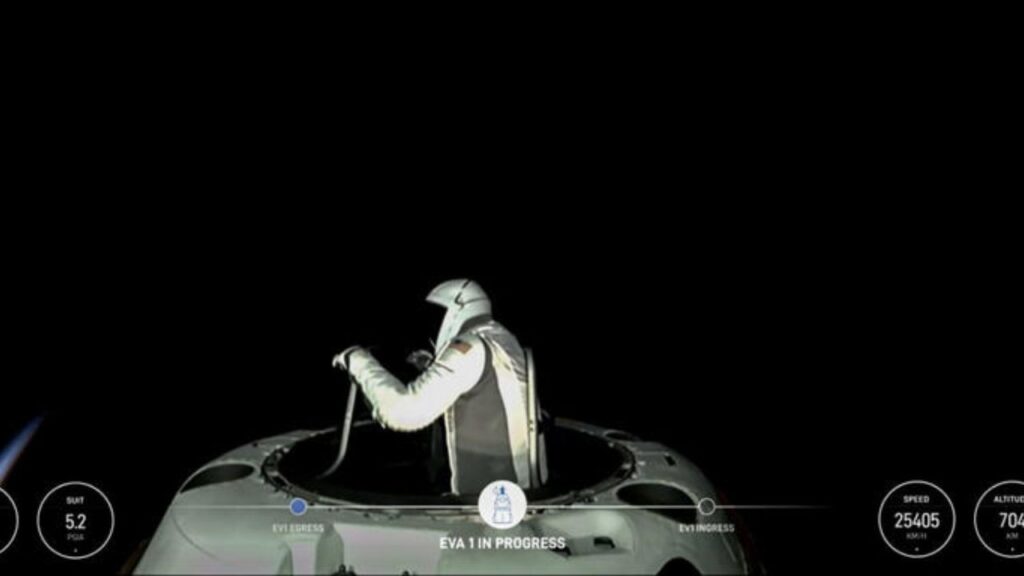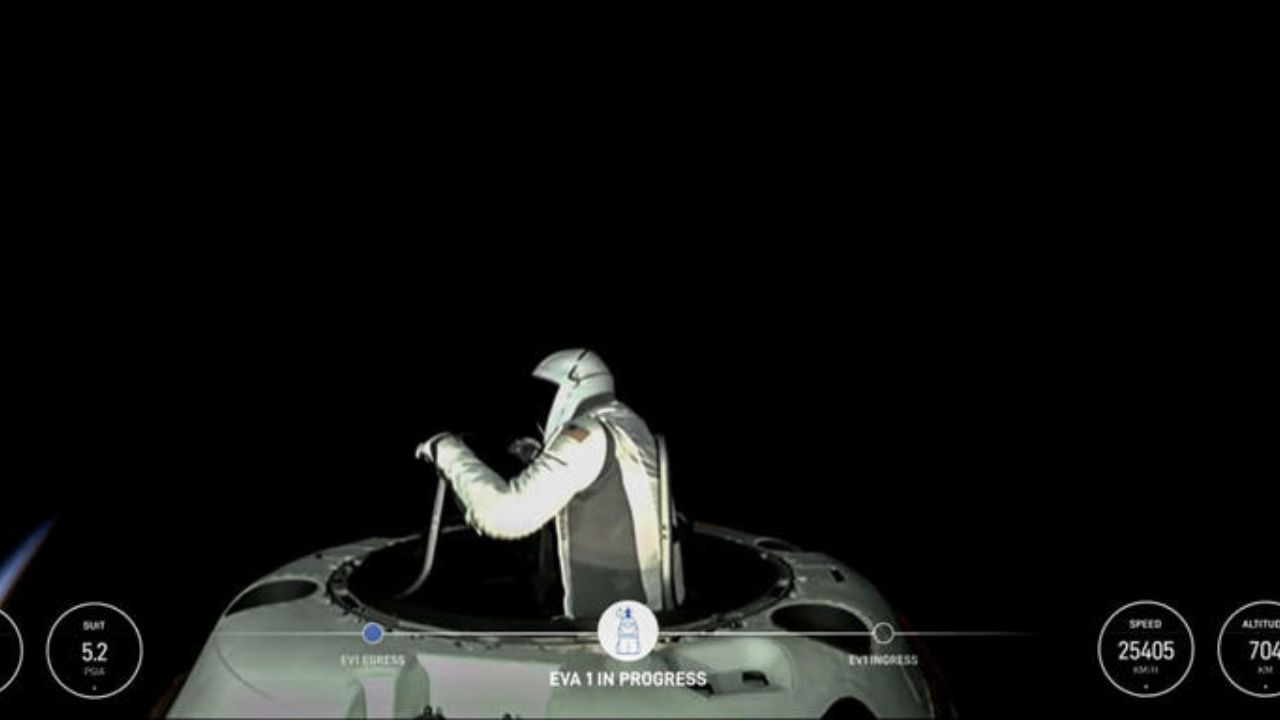SpaceX, Polaris Dawn, commercial spacewalk, Elon Musk, Starship, Crew Dragon, Falcon 9, Jared Isaacman, private space exploration, Starlink, space mission, commercial space industry, first spacewalk, space research, human spaceflight
SpaceX makes history with the Polaris Dawn mission, completing the first-ever commercial spacewalk. Learn about the mission’s success, its impact on the space industry, and what lies ahead for SpaceX in private space exploration.

SpaceX Achieves a Milestone as Polaris Dawn Crew Completes First-Ever Commercial Spacewalk
SpaceX, a company renowned for revolutionizing space travel, has notched another major victory with its recent Polaris Dawn mission. On Thursday, the crew of this private space venture made history by performing the first-ever commercial spacewalk. This marks a significant milestone for both SpaceX and the broader commercial space industry. The spacewalk, also known as an extravehicular activity (EVA), showcases SpaceX’s continued leadership in human spaceflight, at a time when its competitor Boeing is struggling to get its Starliner spacecraft ready for crewed missions.
This achievement is part of SpaceX’s broader efforts to push the boundaries of space exploration and bring commercial spaceflight to new heights. The Polaris Dawn mission, in particular, is just one of many initiatives from SpaceX that aim to enhance our understanding of space, expand humanity’s presence in space, and offer unprecedented experiences to private astronauts.
SpaceX’s Commercial Spacewalk: A Landmark Moment
The spacewalk on Thursday was a groundbreaking event, not just for SpaceX but for the commercial space industry as a whole. While spacewalks have long been a staple of government space agencies like NASA, this is the first time a commercial mission has included an EVA. The event was made all the more extraordinary given that the SpaceX Crew Dragon capsule does not have an airlock—a feature commonly used in traditional spacewalks to maintain cabin pressure while astronauts exit and enter the spacecraft. Instead, the entire cabin was depressurized, exposing the four astronauts inside to the vacuum of space.
The spacewalk was carried out by Polaris Dawn mission commander Jared Isaacman, a veteran private astronaut and the CEO of Shift4 Payments, Inc. Isaacman made headlines in 2021 when he led the all-civilian Inspiration4 mission, which was also operated by SpaceX. He opened the capsule’s forward hatch at 6:49 a.m. Eastern Time, marking the beginning of the historic EVA. “From here, it sure looks like a perfect world,” Isaacman remarked as he gazed at Earth from the capsule. After completing a series of tests on the spacewalk equipment, Isaacman returned to the capsule at 7:00 a.m. Eastern Time.
Next, Polaris Dawn mission specialist Sarah Gillis, a lead space-operations engineer at SpaceX, conducted her spacewalk. The hatch was closed at 7:16 a.m., and the cabin was repressurized shortly after. In total, the spacewalk lasted for one hour and 46 minutes, making it a quick yet impactful mission.
The Polaris Dawn Mission and Its Objectives
The Polaris Dawn mission is part of the broader Polaris Program, which was conceptualized by Jared Isaacman to continue expanding the frontiers of private space exploration. The mission carried four astronauts into space aboard a SpaceX Falcon 9 rocket, which launched from complex 39A at NASA’s Kennedy Space Center in Florida on Tuesday. On Wednesday, the spacecraft reached its apogee, or highest point in orbit, of over 870 miles, setting a record for the farthest distance humans have traveled from Earth since the Apollo program. This is another feather in the cap for SpaceX, which continues to break new ground in human spaceflight.
The Polaris Dawn mission has numerous objectives, including advancing scientific research. The crew is conducting 36 experiments aimed at improving human health on Earth as well as understanding the effects of long-duration spaceflights on the human body. These experiments are expected to provide insights into health challenges that future astronauts may face during missions to the Moon, Mars, and beyond.
Additionally, the mission is the first to test SpaceX’s Starlink laser-based communications system in space. Starlink, another major SpaceX initiative, is a satellite-based internet service designed to provide high-speed internet access across the globe, particularly in remote areas. The success of these tests could pave the way for enhanced communications in future space missions, including interplanetary travel.
SpaceX vs. Boeing: The Battle for Human Spaceflight
While SpaceX continues to soar to new heights, its competitor Boeing is facing significant challenges. Boeing’s Starliner spacecraft, which was supposed to serve as NASA’s backup option for ferrying astronauts to and from the International Space Station (ISS), has encountered numerous delays and technical issues. Recently, NASA opted to prioritize SpaceX’s Crew Dragon spacecraft for upcoming missions, dealing a significant blow to Boeing.
The success of the Polaris Dawn mission and the first commercial spacewalk further cements SpaceX’s dominance in the field of human spaceflight. SpaceX has not only pioneered reusable rocket technology but has also maintained a rigorous launch schedule for both crewed and uncrewed missions. This consistency has earned SpaceX a reputation for reliability, a trait that NASA values highly as it plans future missions to the Moon and Mars.
Starship: The Next Frontier for SpaceX
Looking ahead, SpaceX has even more ambitious plans on the horizon. The Polaris Program, for instance, will culminate in the first human spaceflight aboard SpaceX’s Starship rocket. Starship is the most powerful rocket ever built, boasting more than twice the thrust of NASA’s Saturn V rockets, which carried astronauts to the moon in the 1960s and 70s. Together with its Super Heavy booster, Starship stands 396 feet tall, making it taller than the Statue of Liberty.
SpaceX has already conducted several test flights of Starship, including a recent one in June that reached space and completed a “soft splashdown” in the Indian Ocean. Although these test flights are uncrewed, SpaceX plans to launch the first crewed Starship missions to Mars within the next four years. According to Musk, the first Starships to Mars will launch within two years, with these missions being uncrewed to test the reliability of the landings. If all goes well, crewed missions could follow shortly after.
Musk has long been vocal about his vision for making humanity a multi-planetary species, and Starship is a critical part of that goal. The rocket is designed to carry large numbers of passengers and cargo, making it ideal for establishing a sustainable presence on Mars.
What’s Next for SpaceX?
The Polaris Dawn mission is just one chapter in SpaceX’s broader space exploration saga. In addition to human spaceflight, SpaceX is also involved in a variety of other projects, including the development of Starlink, which aims to provide global satellite internet coverage. Despite speculation about a possible initial public offering (IPO) for Starlink, Elon Musk has downplayed these rumors, citing the high legal burdens and pressure for short-term results that public companies face. Last year, Musk also seemed to rule out the possibility of a Starlink IPO in 2024.
In addition to Starship and Starlink, SpaceX is also planning several other groundbreaking missions. One of these is the Fram2 mission, which could take place as early as this year. The Fram2 mission will be the first human spaceflight mission to fly over Earth’s poles, offering a unique perspective of our planet. The mission will be commanded by Bitcoin entrepreneur Chun Wang, further illustrating the growing role of private individuals in space exploration.
Conclusion
The Polaris Dawn mission and its historic commercial spacewalk mark another significant milestone for SpaceX. Under the leadership of Elon Musk, SpaceX has continued to push the envelope in human spaceflight, setting new records and breaking down barriers that were once considered insurmountable. With future plans that include crewed missions to Mars, the deployment of the Starlink satellite network, and the ongoing development of the Starship rocket, SpaceX is solidifying its role as a key player in the future of space exploration.
As SpaceX looks ahead, it remains clear that the company’s ambitions extend far beyond Earth. The Polaris Program, with its focus on private space exploration and advancing scientific knowledge, is just the beginning of what promises to be an exciting new era in human space exploration. Through its innovative technology, relentless drive, and willingness to take risks, SpaceX is leading humanity toward a future where space is no longer the final frontier, but just the next step in our journey.
Read More
